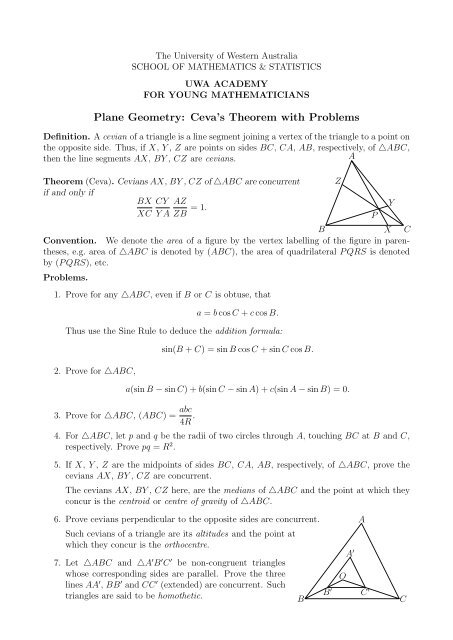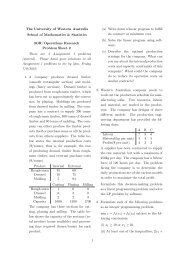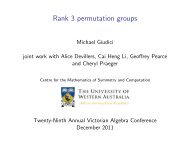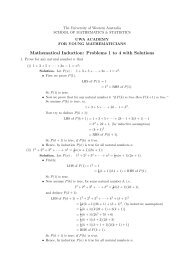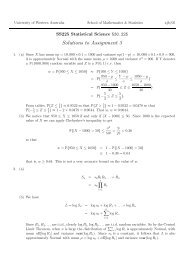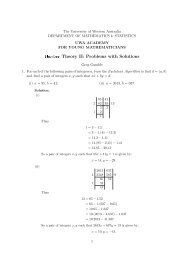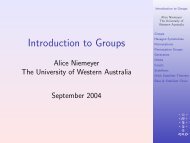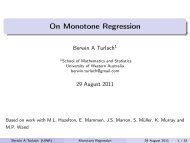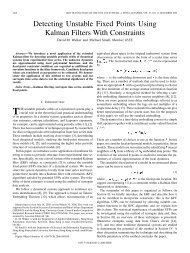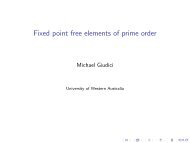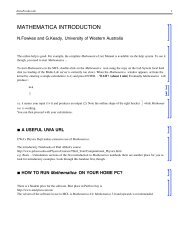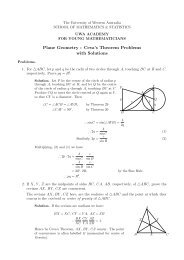Ceva's Theorem with Problems - The University of Western Australia
Ceva's Theorem with Problems - The University of Western Australia
Ceva's Theorem with Problems - The University of Western Australia
Create successful ePaper yourself
Turn your PDF publications into a flip-book with our unique Google optimized e-Paper software.
<strong>The</strong> <strong>University</strong> <strong>of</strong> <strong>Western</strong> <strong>Australia</strong><br />
SCHOOL OF MATHEMATICS & STATISTICS<br />
UWA ACADEMY<br />
FOR YOUNG MATHEMATICIANS<br />
Plane Geometry: Ceva’s <strong><strong>The</strong>orem</strong> <strong>with</strong> <strong>Problems</strong><br />
Definition. A cevian <strong>of</strong> a triangle is a line segment joining a vertex <strong>of</strong> the triangle to a point on<br />
the opposite side. Thus, if X, Y , Z are points on sides BC, CA, AB, respectively, <strong>of</strong> △ABC,<br />
then the line segments AX, BY , CZ are cevians.<br />
A<br />
<strong><strong>The</strong>orem</strong> (Ceva). Cevians AX, BY , CZ <strong>of</strong> △ABC are concurrent<br />
if and only if<br />
BX CY AZ<br />
XC Y A ZB = 1.<br />
B<br />
X C<br />
Convention. We denote the area <strong>of</strong> a figure by the vertex labelling <strong>of</strong> the figure in parentheses,<br />
e.g. area <strong>of</strong> △ABC is denoted by (ABC), the area <strong>of</strong> quadrilateral P QRS is denoted<br />
by (P QRS), etc.<br />
<strong>Problems</strong>.<br />
1. Prove for any △ABC, even if B or C is obtuse, that<br />
a = b cos C + c cos B.<br />
Thus use the Sine Rule to deduce the addition formula:<br />
2. Prove for △ABC,<br />
3. Prove for △ABC, (ABC) = abc<br />
4R .<br />
sin(B + C) = sin B cos C + sin C cos B.<br />
a(sin B − sin C) + b(sin C − sin A) + c(sin A − sin B) = 0.<br />
4. For △ABC, let p and q be the radii <strong>of</strong> two circles through A, touching BC at B and C,<br />
respectively. Prove pq = R 2 .<br />
5. If X, Y , Z are the midpoints <strong>of</strong> sides BC, CA, AB, respectively, <strong>of</strong> △ABC, prove the<br />
cevians AX, BY , CZ are concurrent.<br />
<strong>The</strong> cevians AX, BY , CZ here, are the medians <strong>of</strong> △ABC and the point at which they<br />
concur is the centroid or centre <strong>of</strong> gravity <strong>of</strong> △ABC.<br />
Z<br />
P<br />
Y<br />
6. Prove cevians perpendicular to the opposite sides are concurrent.<br />
Such cevians <strong>of</strong> a triangle are its altitudes and the point at<br />
which they concur is the orthocentre.<br />
7. Let △ABC and △A ′ B ′ C ′ be non-congruent triangles<br />
whose corresponding sides are parallel. Prove the three<br />
lines AA ′ , BB ′ and CC ′ (extended) are concurrent. Such<br />
triangles are said to be homothetic.<br />
B<br />
A ′<br />
A<br />
O<br />
B ′ C ′<br />
C
A<br />
8. Let AX be a cevian <strong>of</strong> △ABC <strong>of</strong> length p dividing BC<br />
into segments BX = m and XC = n. Prove<br />
a(p 2 + mn) = b 2 m + c 2 n.<br />
c<br />
p<br />
b<br />
This result is known as Stewart’s <strong><strong>The</strong>orem</strong>.<br />
Hint. Use the Cosine Rule on each <strong>of</strong> △ABX and B m X n C<br />
△AXC, in each case taking the cosine <strong>of</strong> the angle at X. What relationship do the cosines<br />
<strong>of</strong> supplementary angles have?<br />
A<br />
9. Prove that the medians <strong>of</strong> a triangle dissect the triangle<br />
into six smaller triangles <strong>of</strong> equal area.<br />
Hint. Suppose in the diagram that x, y, z represent the<br />
z y<br />
Z Y<br />
areas <strong>of</strong> the smaller triangles they lie in. Show the two<br />
triangles marked x have the same area, by showing they z G<br />
y<br />
have a common altitude, and similarly for y and z. <strong>The</strong>n<br />
x x<br />
in a similar way show 2x + z = 2y + z. Continue from B X C<br />
there.<br />
10. Prove the medians <strong>of</strong> a triangle divide each other in the ratio 2 : 1, i.e. the medians <strong>of</strong> a<br />
triangle trisect one another.<br />
11. Prove that each (internal) angle bisector <strong>of</strong> a triangle<br />
A<br />
α α<br />
divides the opposite side into segments proportional in<br />
length to the adjacent sides, e.g. if AX is the cevian c<br />
b<br />
<strong>of</strong> △ABC that bisects the angle at A internally, then<br />
BX : XC = c : b.<br />
Hint. Use the Sine Rule on each <strong>of</strong> △ABX and △AXC,<br />
in each case taking the sine <strong>of</strong> the angle at X.<br />
B X<br />
C<br />
What relationship do the sines <strong>of</strong> supplementary angles have?<br />
12. <strong>The</strong> angle bisector <strong>of</strong> the angle between two sides is the locus <strong>of</strong> points that are equidistant<br />
from the sides making the angle. One consequence <strong>of</strong> this is that any pair <strong>of</strong> internal angle<br />
bisectors <strong>of</strong> a triangle meet at a point that is equidistant from all three sides <strong>of</strong> the triangle,<br />
and hence in fact the three internal angle bisectors are concurrent.<br />
<strong>The</strong> point at which the angle bisectors <strong>of</strong> a triangle concur is the incentre I, the common<br />
(perpendicular) distance from I to the three sides is the inradius r, and the circle <strong>with</strong><br />
centre I and radius r thus touches each side tangentially and is called the incircle <strong>of</strong> the<br />
triangle.<br />
Find an alternative pro<strong>of</strong> that the (internal) angle bisectors <strong>of</strong> a triangle concur, using<br />
Ceva’s <strong><strong>The</strong>orem</strong> and the result <strong>of</strong> the previous problem.<br />
2


